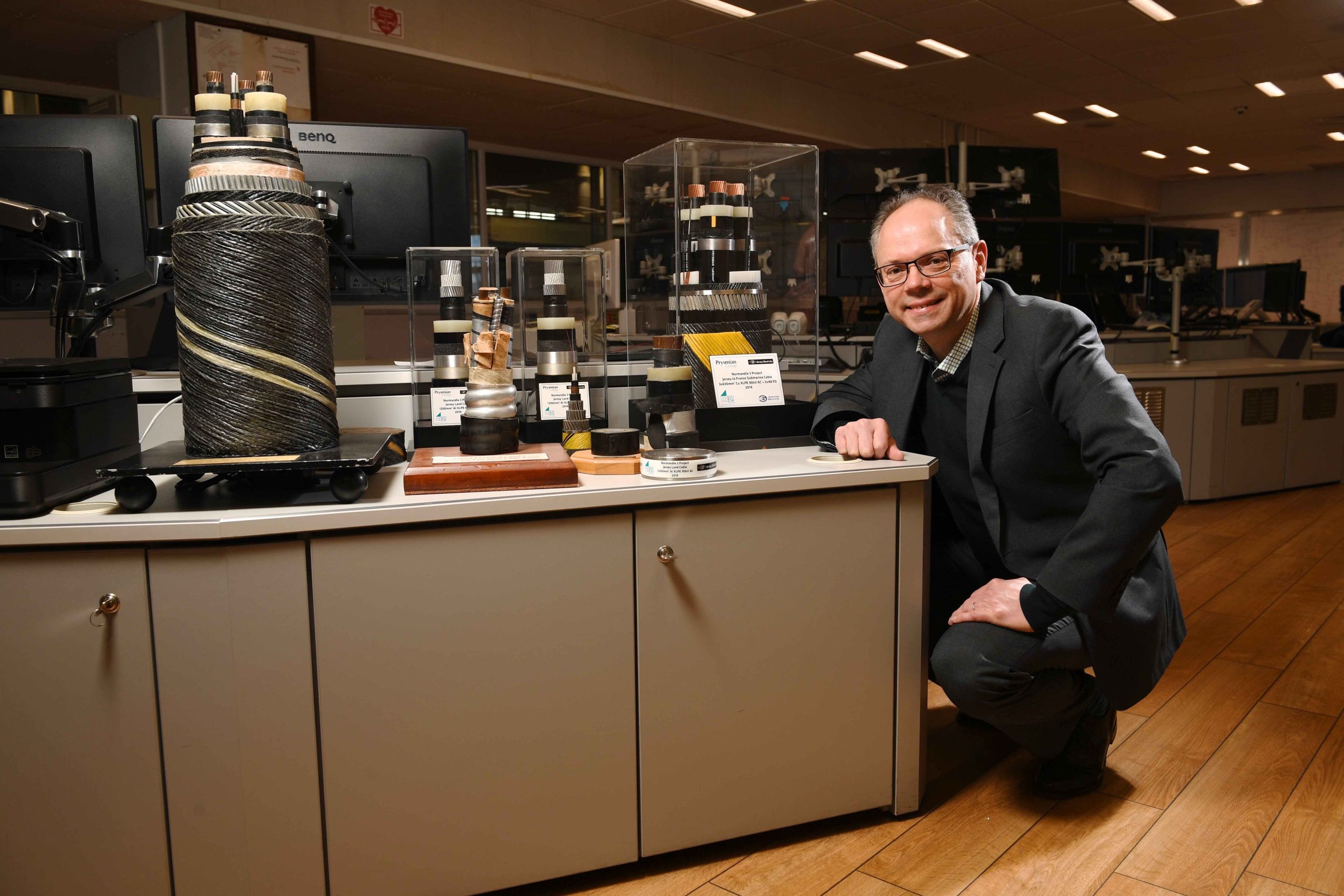Ambitions to create the Channel Islands’ largest infrastructure project have been revealed by Jersey Electricity chief executive Chris Ambler. He spoke to James Jeune about what the multi-billion-pound offshore windfarm project could look like
WITH wildfires raging in Europe, Asia and the US – and the world recording its hottest ever month in July – the need for nations to commit to a green-energy future has never been greater.
And increasing unpredictability in the European emergency markets has only added to the overall benefits of Jersey finally pushing forward with plans to generate its own clean electricity.
With that in mind, Jersey Electricity has been looking at the feasibility of developing a large windfarm which would most likely sit well off the Island’s west and south-west coasts.
Almost all of Jersey’s electricity supply is imported from low-carbon, hydro and nuclear sources in France through three undersea cables.
But there are several advantages to offshore wind, according to Chris Ambler, who took up his role as chief executive of Jersey Electricity in 2008.
‘There is the economic potential to create new jobs, the potential to give access to lower-cost energy for Islanders, the sovereignty and energy-independence advantages and also an opportunity for the government to create value in the form of an income,’ he said.
‘Our ambition here is to successfully deliver the Channel Islands’ largest infrastructure project – a one-gigawatt offshore wind farm – which is what we would love to see built here. This would create a new long-term source of clean, green power that Jersey can benefit from and feel proud of.’
Last year, Mr Ambler hinted at the renewed push for such a project when he said Jersey Electricity was ‘accelerating research’ into the creation of an offshore wind farm within the Island’s territorial waters.
He estimated that ‘a few hundred’ jobs could be created in the process.
‘These could be jobs to support the operation and maintenance of an offshore wind farm and could include things like surveying and even certain construction activities, which might take place here,’ he added.
He noted that some developments in the UK had even sparked ‘a little tourism industry’ in the form of boat trips for members of the public to visit wind farms and learn about the technology.
Mr Ambler stressed that the development would be ‘transformational’ for the Island’s energy systems and could also provide ‘an opportunity for Jersey to enhance its international reputation’.
‘We want Jersey to project itself as an island that is taking responsibility and is that is pursuing larger-scale alternative forms of energy generation,’ he said.
A possible location for the project is included within the Bridging Island Plan, which says that an Offshore Wind Pre-Feasibility Study had concluded that Jersey has ‘significant offshore wind potential within its waters’.
It highlighted a potential site south-west of Jersey (see map above, right).
Mr Ambler said: ‘There is a lot of surveying work that is required to properly assess the best location [for a windfarm].
‘You have to look at the marine environment, the seabed conditions, grid connections, quality of the resource – because clearly you need the wind to turn the turbines – and other things like aviation and shipping. Many factors come into play and it is effectively an optimisation exercise.’
Environment Minister Jonathan Renouf revealed this month that the Island had ‘been approached by commercial partners who want to [build] a wind farm in our waters’.
Mr Ambler said: ‘We know that the project is of interest to external developers. There have been a few approaches.
‘We are doing quite a lot of work on feasibility analysis and how a partnership should be constructed and we are exploring prospective partners because choosing the right partner is extremely important to unlock the opportunity. We are also looking at grid connections and the Island’s energy system, what that looks like in the future and how an offshore wind farm might support that.’
He noted that this would include an assessment of the potential impact the project could have on the company’s long-term contractual agreement with Electricité de France.
‘Notwithstanding the fact that we will dramatically increase the Island’s sovereignty and independence, we will still depend on imported power from France for those situations when the wind doesn’t blow and the sun doesn’t shine,’ he said.
‘All of these things need to be properly assessed, to make sure that the development of offshore wind does not cause a consequential and adverse impact on a different part of the energy system, which could lead to higher costs for the community. Clearly that is something we want to avoid.’
According to Mr Ambler, a one-gigawatt offshore wind farm would be capable of generating ‘between seven or eight times the Island’s annual electricity requirement’.
‘It is substantially more than we can absorb into the Island, so we have to look at alternative ways of getting energy into the French system,’ he explained. ‘We would have to sell some to third parties.’
He echoed Deputy Renouf’s recent comments that an operational wind farm was ‘somewhere between eight and ten years’ away – and estimated that a one-gigawatt project would cost somewhere in the region of two to three billion pounds.
‘Clearly that is not going to be funded from within Jersey. We have to look at external investors to come and deploy that kind of capital,’ he acknowledged.
‘Because it is reliant on inward investment from third parties, we have to make sure at all times that this is an investable proposition. That means that it must be attractive for external investors and that we – working with government and with our consortium partners – do everything we can to de-risk the project.
‘What we would love to see is an opportunity for the community to really benefit themselves, in the form of lower-cost energy, but also potentially an opportunity to invest in offshore renewables themselves. Whether it is at a lower level – perhaps an investment of £500 or £1,000 – to actually take an ownership interest in the development, right the way through to [investment] at a more significant level.
‘We want a development in Jersey that the Island can feel proud of, that it can be a part of and that it can benefit from.’
Jersey Electricity has also been progressing the development of other local, renewable sources such as solar technologies.
Earlier this year, the utility submitted an application to build a solar farm on a cluster of fields at Sorel.
If approved, the farm would be one of a number that JE hopes to build around the Island. The company already has permission for one in St Clement. If all sites are approved, they would collectively generate 25MW of electricity, equivalent to 5% of the Island’s annual demand.
Mr Ambler said that the company was also trying to be innovative by pursuing ‘agrivoltaic’ developments combining solar PV structures with agriculture.
‘[These are] dual-use sites whereby we can have solar arrays on a plot of land, as well as graze sheep, have chickens and grow certain produce. We really like that idea and we are pursuing that with a number of landowners,’ he explained.
‘Unlike a housing development, a ground-based solar PV array is a temporary construction. Once you put a house on a plot of land and put a concrete foundation down, it never gets turned back into bare earth, whereas solar PV can. So not withstanding the very long asset lives [of the projects] – 30 to 40 years – you can get the land back because it’s basically just a steel structure that is driven into the earth.’
Tidal power
Earlier this year, Alderney’s government invited expressions of interest from third parties in relation to harnessing the power of the tides around the island.
And last month French officials unveiled plans to invest 65 million euros in a tidal farm near Alderney.
‘In all cases, when you run the numbers and do the analysis, the risks are very high [for a tidal development]. The technology is early stage and the cost of the energy that is capable of being generated from these facilities is far higher than the alternatives – typically four to five times the cost of imported power from France,’ Mr Ambler said.
‘I do think there is potential here for us to pursue tidal but we are 15 to 20 years away from an economically viable proposition unless the government chooses to subsidise it. The problem with subsidies is where do they come from.’
Price hikes
In June, Jersey Electricity announced a 12% price increase that will take effect from 1 January 2024 to keep pace with rising costs caused by the ‘volatility of international energy prices’.
The news followed multiple rises implemented over the past two years and is expected to add around £3 per week to the average annual domestic electricity bill of approximately £1,200.
Mr Ambler said: ‘We, as a business, are hugely proud of the extent to which we have been able to shelter Islanders from the pretty traumatic situation in energy markets globally but particularly in Europe.
‘Our hedging and contract structure have helped Jersey avoid costs of around £100 million per year. That’s around £2,500 per household of avoided cash outflows.
‘Power prices in Jersey are presently just a little over half those of the UK, which is still a very strong position. However, we wouldn’t want to encourage complacency.
‘There is upward pressure and Islanders should do everything they possibly can to reduce consumption.’






